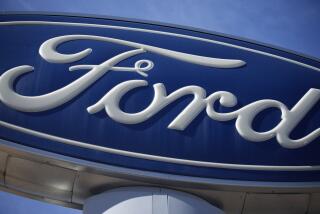Detroit Looks to ‘Blends’ to Keep Sales Humming
- Share via
U.S. auto buyers, whether bored with the industry’s meat-and-potatoes vehicles or unnerved by rising interest rates and gasoline prices, are pulling back from some of the truck products that have fattened sales numbers for several years.
So is it possible that the national appetite for sport-utility vehicles, minivans and pickups has finally been sated?
Will an auto industry that has been carrying most of its eggs in pickup beds now make an abrupt U-turn and fill the supply lanes with streams of sedans, coupes and roadsters?
Don’t bet on it.
Truck-based vehicles continue to account for almost half of all U.S. auto sales--a 48.7% market share in May--and the major auto makers say trucks could soon account for as much as 70% of sales as a flood of new and highly specialized models hits showrooms.
But though trucks will continue to reign, what we call trucks is a category rapidly morphing into a highly segmented group of vehicles: traditional body-on-frame pickups, vans and large SUVs in one class and a variety of car-truck “blends” in another.
Unlike past market metamorphoses, the shifts shouldn’t create more than temporary bumps in the road for the domestic auto makers. The domestics, in fact, are leading the charge this time, rather than responding late and lazily to changes instigated by Asian and European competitors.
“Look at the old Dodge Ram” pickup, said marketing consultant George Peterson, president of AutoPacific Inc. in Tustin. “Chrysler kept the same platform from 1970 to 1993. But now the car makers are shortening product cycles and making the investment to keep their vehicles more competitive. And when you are making $8,000 or so per truck, you can afford to discount the price for a while to move out older models when they start stacking up.”
The issue isn’t whether the domestic auto makers can compete, but whether they will have the right products at the right time.
Peterson says they will.
“This time, they listened to consumers and heard them when they said they wanted cars that had more room and more versatility and trucks that had better fuel economy and a more comfortable ride,” he said. “And they reacted by deciding that they could derive SUV-type vehicles from car platforms and give everybody what they wanted.”
The new blends are category-busting vehicles such as Chrysler’s hot PT Cruiser, the Lexus RX 300, Pontiac’s minivan-based Aztek, Ford’s soon-to-be-released Escape and Chevrolet’s Avalanche utility pickup, which features a full-size, four-door cabin and a short bed that can be lengthened by collapsing the back seats and the wall that separates the passenger compartment from the cargo area.
They are trucks and truck-like vehicles built on car-like platforms, and they blend the attributes of both to provide the utility, visibility and ease of entry of a truck with the comfortable ride, crisp handling and plush--or at least plusher-than-a-truck--appointments of a car.
But inventory figures for May show that though some consumers are apparently holding back and waiting for these vehicles to hit the market, a number of mainstream trucks and vans have crossed the double line into the 90-day-and-more supply lane where auto makers and dealers begin to worry about sales slowdowns.
“Certain parts of the truck market have been so strong for so long that almost anyone who wanted one has bought one,” said auto market analyst Michael Luckey, president of Luckey Consulting Group in Kinnelon, N.J. “So the market driven by demand for replacements [of aging trucks] is pretty weak.”
That’s not a dire prediction, though. In fact, Luckey and other analysts and industry watchers insist that even with May’s 2% year-over-year sales decline and a potentially soft summer, this year will still beat 1999’s record sales by a few hundred thousand vehicles.
“I’m predicting that it will be a 17.1-million-unit year,” Luckey said, “and I’m one of the most conservative.”
But even if sales this year were to drop by a million units from last year’s record 16.9 million, it would be the second-best year in the auto industry’s history.
And though some parts of the truck market are flattening out, the new car-based truck models “are looking good,” Luckey said.
But the slow truck segments, and the expense that auto makers are incurring with bigger incentives, are hurting domestic auto makers in the eyes of market analysts--in particular No. 1 General Motors Corp. and No. 3 DaimlerChrysler Corp., which together accounted for virtually all of the industrywide sales drop in May.
Lehman Bros. auto analyst Nicholas Lobacarro--who believes a sales slowdown is overdue--recently advised investors to sell GM and DaimlerChrysler stock and buy shares of No. 2 Ford Motor Co., suggesting that growing truck inventories could mean that manufacturers that have geared up for record sales won’t be able to cool production fast enough when the downturn finally does occur.
Michael P. Ward, a Salomon Smith Barney automotive specialist, said he is neutral on both GM and Ford and considers both stocks to be a medium risk, reflecting his belief that the market will continue to undervalue auto stocks in anticipation of a sales slump.
For bargain-hunting consumers more interested in deals than in being trendy, the truck market situation could be good news.
When inventories climb above the 90-day mark, auto makers start cutting prices and piling on incentives. With the average truck priced to fetch a profit of about $7,000--or as high as $15,000 on ultra-large SUVs such as Ford’s Expedition and Excursion models--manufacturers have a lot of room for freewheeling deals.
But most of those deals will be on older and decidedly unglamorous products, such as GM’s Chevy S-10 and GMC Sonoma mini-pickups, Dodge’s full-size Ram pickups and Chrysler’s minivans.
To help handle looming oversupply, GM says it will trim truck-building activity by 11% later this year. DaimlerChrysler says it will cut back on Jeep Cherokees. Ford has already slashed production of its giant Excursion SUV by 25%, and on Friday the company announced plans to idle an Ohio factory to ease oversupply of the Mercury Villager minivan and its twin, the Nissan Quest.
Sales volume always mimics traffic on the showroom floor, and showroom traffic slowed down in May, said Art Spinella, vice president of CNW Marketing/Research, a Bandon, Ore., firm that tracks auto industry incentives.
“The industry now is looking at softer midsummer sales,” Spinella said. “So to boost traffic and whet appetites for purchases, the factories are starting to put in rebates, discount lease rates and other incentives.”
In the truck market, incentives have been gradually increasing for the last three years.
“In the full-size SUV segment, the average discount from the MSRP [manufacturer’s suggested retail price] was about 2.5% in 1997, and now it is around 10% as people stop looking for full-size SUVs,” Spinella said.
The shift of interest toward the “blends” and other highly specialized truck products is part of a natural evolution of the market.
“Customers are not satisfied with what everyone else has. They want more customization--vehicles suited to more specific needs,” said Gary White, head of GM’s full-size truck line. “We’d be crazy now to think we can just keep building 100,000 of the same type vehicle and be successful. We need to serve fragments of the market.”
GM, which has more cars and trucks on the 90-day inventory list than any other manufacturer, figures that by pushing development of new types of vehicles, it will see its truck sales soar. The company said last week that it expects trucks and car-truck blends to account for 53% of its sales this year--the first time in history that they will outsell cars--and as much as 60% of sales next year.
At Ford, which is challenging GM as the world’s No. 1 car maker, analysts are predicting that truck-based models could account for as much as 70% of all auto sales within a decade, said Germinder Bedi, vice president for North American truck planning.
Ford, GM and the former Chrysler Corp. once dominated the truck market and were the only players in the full-size pickup and SUV segments.
But Japanese leader Toyota Motor Corp. rocked the industry last year with the introduction of the Tundra, a full-size, V-8-powered pickup that has topped the domestic brands in customer-satisfaction surveys. And now Nissan Motor Co. has announced plans to build a full-size pickup, and Honda Motor Co. has said it is thinking of developing one.
Even the Germans are tinkering with the once uniquely American format: Volkswagen showed a full-size pickup concept at this year’s Detroit auto show, and both VW and Porsche are building car-based sport-utility blends that will hit showrooms in 2002 and 2003.
“If the Asians and Europeans are looking at full-size pickups, then they also are potential competitors in the full-size SUV market,” said Ed Molchany, head of Ford’s Explorer Sport and Explorer Sport Trac “multipurpose vehicle” team. “So it makes sense for us to continually refine, improve and enhance to meet customer needs and demands.”
(BEGIN TEXT OF INFOBOX / INFOGRAPHIC)
Lot Full
The “days supply” of cars and trucks in dealership inventories is a good gauge of how well the auto companies are doing and how well various models are selling. When inventories climb above a 90-day supply, the industry starts cutting production or piling on incentives--or both. A look at some key trucks in that category:
*--*
Make/model Days supply* Cadillac Escalade SUV 128 GMC Sonoma mini-pickup 125 Infiniti QX4 SUV 115 Chrysler Town & Country minivan 113 Ford Excursion SUV 108 Chrysler Voyager minivan 103 Honda Passport SUV 102 GMC Sierra pickup 99 Chevrolet C/K pickup 97 Chevrolet S-10 mini-pickup 95 Mercury Mountaineer SUV 95 Dodge Ram pickup 93 Mazda B-Series mini-pickup 93
*--*
* As of May 31
Source: Ward’s AutoInfoBank






